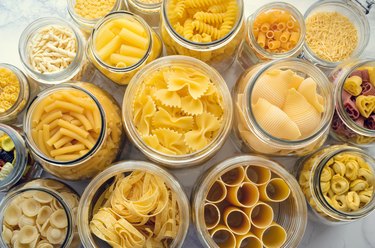
Carbs — short for carbohydrates — may be a little out of fashion right now, but they are actually a very important nutrient that is the body's first choice for fuel. But how many calories are in a carb is worth knowing when you're thinking about how to control your food portions.
Tip
The exact calories per gram of carbs can vary a little, but the official figure for use on food labels is 4 calories per gram, according to the United States Department of Agriculture (USDA)
Video of the Day
Types of Carbs
According to the Food and Drug Administration (FDA), there are actually four different types of carbs, which are starches, sugars, sugar alcohols and fiber:
Video of the Day
- Sugar is the simplest form of carbohydrate that occurs naturally in fruits, vegetables and milk. A lot of sugar is added to food, too.
- Starch is made up of many sugar units bonded together and occurs naturally in vegetables like potatoes, as well as in grains such as wheat, rice and corn.
- Sugar alcohols are found naturally in small amounts in a variety of fruits and vegetables and are also manufactured and added as reduced-calorie sweeteners to foods such as chewing gum, dairy desserts and sweets.
- Dietary fiber, which can be soluble or insoluble, is found in fruits, nuts and seeds, vegetables, whole grains and pulses. Getting enough high-fiber foods helps prevent constipation, makes you feel full and can interfere with the absorption of dietary fat and cholesterol.
Calories in Carbs
Sugar and starches are the most common carbs, and the 4 calories per gram holds good for this type. (In fact, the British Nutrition Foundation points out that the exact calories per gram of carbs is 3.75, but rounding up makes things simpler.)
Fiber and sugar alcohols are actually slightly different when it comes to calories. Fiber has traditionally been thought of as calorie-free, but the FDA has ruled that soluble fiber should be labelled as having 2 calories per gram and sugar alcohols between 0 and 3 calories per gram.
You've got the skinny on how many calories are in a carb, but don't forget proteins and fats also supply calories. The USDA says protein has 4 calories per gram — the same as carbs — but fat has more than twice this amount, at 9 calories per gram, which means it is easier to overeat fat calories than those from carbs and protein. Why is it, then, that people get so worried about carbs being fattening and unhealthy?
The reason may be that many people only think of foods like cookies, desserts and donuts when they hear the word "carbs," lumping all carbs into the "bad for you" category.
Make Calories in Carbs Count
In fact, the Harvard School of Public Health explains that dietary carbs are the body's primary energy source, providing the glucose that fuels everything from breathing and thinking to walking and running.
Rather than fixating about the exact calories per gram of carbs, or how many calories are in a carb, the Harvard School of Public Health's recommendation is to focus on the quality of carbs. Making calories in carbs count means choosing more of them in the form of unprocessed or minimally processed whole grains, vegetables, fruits and beans. These deliver vitamins, minerals, fiber and a host of important phytonutrients.
Carbs to cut down on include white bread, pastries, cookies, sodas and other highly processed or sugary foods. These items contain easily digested carbohydrates that may contribute to weight gain, interfere with weight loss and promote diabetes and heart disease.
- USDA: "How Many Calories are in One Gram of Fat, Carbohydrate, or Protein?"
- Food and Drug Administration: "Total Carbohydrate"
- British Nutrition Foundation: "Carbohydrate"
- Food and Drug Administration: "CFR - Code of Federal Regulations Title 21"
- Harvard Health Publishing: "The Smart Way to Look at Carbohydrates"